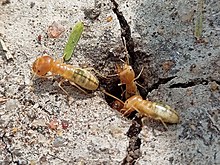
The Formosan termite is a species of termite local to southern China and introduced to Taiwan, Japan, South Africa, Sri Lanka, Hawaii, and the continental United States.
The wildlife of Sri Lanka includes its flora and fauna and their natural habitats. Sri Lanka has one of the highest rates of biological endemism.

Lannea coromandelica, also known as the Indian ash tree, is a species of tree in the family Anacardiaceae that grows in South and Southeast Asia, ranging from Sri Lanka to Southern China. It is commonly known as Gurjon tree and is used in plywoods for its excellent termite resistance properties. It is most commonly grows in exposed dry woodland environments, where the tree is smaller and more crooked. In more humid environments it is a larger spreading tree that can become 20 meters tall. In Sri Lanka Lannea coromandelica often grows on rock outcrops or inselbergs.
Postelectrotermes militaris, the up-country tea termite, is a species of drywood termite of the genus Postelectrotermes. It is native to India and Sri Lanka. It is a serious pest of tea.
Neotermes greeni, is a species of drywood termite of the genus Neotermes. It is native to India and Sri Lanka. It closely resembles Postelectrotermes militaris. It is a minor pest of tea in Sri Lanka, and major pest of mango in India.
Neotermes kemneri, is a species of dry wood termite of the genus Neotermes. It is native to India and Sri Lanka.
Kalotermes jepsoni, is a species of damp wood termite of the genus Kalotermes. It is native to India and Sri Lanka. It usually prefers to live in dead and decaying wood, but sometimes can be seen in live wood. It is a major pest of tea in Sri Lanka.
Glyptotermes ceylonicus, is a species of damp wood termite of the genus Glyptotermes. It is endemic to high elevations Sri Lanka. It is a pest of dead and decaying wood of Hevea, Theobroma, Ficus, and Acacia species.
The Low-country tea termite,, also known as Low country live wood termite, is a species of damp wood termite of the genus Glyptotermes. It is endemic to high elevations Sri Lanka. It is a major pest of tea in low country area of Sri Lanka.
Cryptotermes bengalensis, is a species of dry wood termite of the genus Cryptotermes. It is native to India, Bangladesh, Thailand and introduced to Sri Lanka. It is found in dead and rotten wood of Ficus species. It is a pest of Diospyros insignis.
Coptotermes gaurii, is a species of subterranean termite of the genus Coptotermes. It is native to South India and Sri Lanka. It is a serious pest of tea in Sri Lanka.
Heterotermes ceylonicus is a species of subterranean termite of the family Rhinotermitidae. It is native to India and Sri Lanka. It is a wood destroying termites, which damage to logs, wooden structures of both natural and man-made such as tree stumps of Gravellia and Hevea brasiliensis, and tea plantations. It can be also found in mounds of Hypotermes obscuriceps.
Prorhinotermes flavus is a species of subterranean termite of the genus Prorhinotermes. It is native to India, Sri Lanka, Andaman Islands and Nicobar Islands. It is found in coastal areas such as mangroves. It shows both dampwood and subterranean termite behavior, nesting in dead trees but foraging on soil as a typical subterranean termite. It is not known to be a pest.
Odontotermes ceylonicus, is a species of termite of the genus Odontotermes. It is native to India and Sri Lanka. Though nests in the ground, they never construct termitaria. It attacks many dead, diseased rotten plant roots and wooden buildings. It is a major pest of sugarcane and a secondary pest of tea.

Odontotermes horni, is a species of termite of the genus Odontotermes. It is native to India and Sri Lanka. It attacks many dead, decaying trees and fertilized soil. Though nests on ground, they do not construct a termitaria. It is a pest of tea, coconut and sugarcane.
Odontotermes koenigi, is a species of termite of the genus Odontotermes. It is native to India and Sri Lanka. It is a pest of tea.
Trinervitermes biformis, the snouted harvester termite, is a species of mound building termite in the genus Trinervitermes, native to India and Sri Lanka. The type species was described from the Bandarawela area of Sri Lanka. It is a pest of sugarcane and brinjal.

Termitomyces eurrhizus species of agaric fungus in the family Lyophyllaceae native to Pakistan, India, Sri Lanka, Burma, southwestern China and Malaysia. The fungus has a symbiotic relationship with termites, its mushrooms growing out of mounds after periods of rainfall. It is eaten in Malaysia and the Indian subcontinent.




